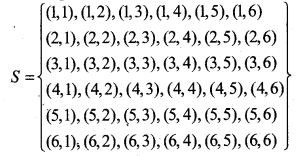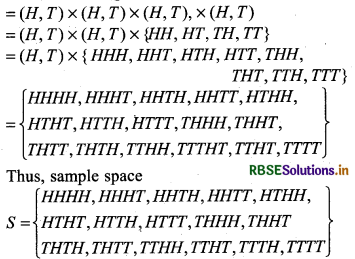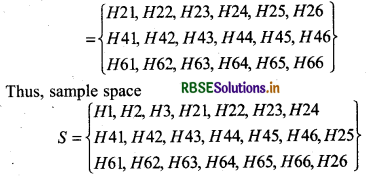RBSE Solutions for Class 11 Maths Chapter 16 Probability Ex 16.1
Rajasthan Board RBSE Solutions for Class 11 Maths Chapter 16 Probability Ex 16.1 Textbook Exercise Questions and Answers.
Rajasthan Board RBSE Solutions for Class 11 Maths in Hindi Medium & English Medium are part of RBSE Solutions for Class 11. Students can also read RBSE Class 11 Maths Important Questions for exam preparation. Students can also go through RBSE Class 11 Maths Notes to understand and remember the concepts easily.
RBSE Class 11 Maths Solutions Chapter 16 Probability Ex 16.1
In each of the following exercises 1 to 7, describe the sample space for the indicated experiment. .
Question 1.
A coin is tossed three times
Answer:
A coin is tossed 3 times.
Results obtaind in 1st throw = (H,T)
then, in 3 throws = {(H,T) × (H, T)} × (H, T)
= {HH, HT, TH, TT} × (H, T)
= {HHH, HHT, HTH, HTT, THH, THT, TTH, TTT}
Thus sample space
S = {HHH, HHT, HTH, HTT, THH, THT, TTH, TTT}
Question 2.
A dice is thrown two times
Sol: A dice is thrown two times
In tossing a dice possible outcomes will be 1,2,3,4,5,6 Thus, in throwing a dice two times obtained result = {1, 2, 3, 4, 5, 6} × {1, 2, 3, 5, 5, 6 Then sample space.

Question 3.
A coin is tossed four times.
Answer:
Result obtained in tossing a coin once = (H, T)
Thus, on-tossing a coin four times, obtained result

Question 4.
A coin is tossed and a die is thrown.
Answer:
Result obtained in tossing a coin = (H, T)
Result obtained in throwing a dice = {1, 2, 3, 4, 5, 6} Then, sample space
S = (H, T) × 1, 2, 3, 4, 5, 6
= {H1, H2, H3, H4, H5, H6, T1, T2, T3, T4, T5, T6}

Question 5.
A coin is tossed and then a die is rolled only in case a head is shown on the coin.
Answer:
In throwing a coin of head appears then a dice is rolled, then obtained result
= (H) × (1, 2, 3, 4, 5, 6)
= {H1, H2, H3, H4, H5, H6}
when tail appears then dice is not rolled
Then, result = (T)
S = {H1, H2, h3, H4, H5, H6, T}
Question 6.
2 boys and 2 girls are in Room X, and 1 boy and 3 girls in Room Y. Specify the sample space for the experiment in which a room is selected and then a person.
Answer:
Let in Room X
Two boys are B1, and B2
Two girls are G1 and G2
and In Room y
1 boys in B3
and 3 girls are G3, G4,G5
Now, X or Y, any room can be selected, and one child from that room is selected, then

Thus, sample space

Question 7.
One die of red colour, one of white colour and one of blue colour are placed in a bag. One die is selected at random and rolled, its colour and the number on its uppermost face is noted. Describe the sample space.
Answer:
Let red colour dice is denoted by R.
White colour dice is denoted by W. and blue colour dice is denoted by B.
Out of these, any one dice can be randomly chosen. Thus, outcomes to select dice = {R, W, B} .
Colour of dice and number appear on top is noted, then
Total outcomes = (R, W, B ) × (1,2,3,4,5,6)

Question 8.
An experiment consists of recording boy-girl composition of families with 2 children.
(i) What is the sample space if we are interested in knowing whether it is a boy or girl in the order of their births?
(ii) What is the sample space if we are interested in the number of girls in the family ?
Answer:
We have, An experiment consists of recording boy-girl composition of families with 2 children
(i) If B is baby boy or G is baby girl in the order of their births, then selection can be done in the following way :
BB, BG, GB, GG
Thus, sample space S = {BB, BG, GB, GG}
(ii) Now, consider sample space in part (1), then
No. of girls in 1st family = 0
No. of girls in 2 nd family = 1
No. of girls in 3rd of family = 1
No. of girls in 4 th family = 2
Thus, set of number of girls in families = (0, 1, 1, 2}
= {0, 1, 2}
Then, sample space = {0, 1, 2}
Question 9.
A box contains 1 red and 3 identical white balls. Two balls are drawn at random in succession without replacement. Write the sample sapce for this experiment.
Answer:
In the following figure 1 red ball in box is represented by R and 3 white balls by W

Two balls, in succession can be selected as
(i) First ball red R and second white W = R,W
(ii) First and second both white balls W = W, W
(iii) First ball white W and second ball red R = W,R Thus, sample space for this experiment
S = {RW, WW, WR}


Question 10.
An experiment consists of tossing a coin and then throwing it second time if a head occurs. If a tail occurs on the first toss, then a die is rolled once. Find the sample space.
Answer:
Result obtained in tossing a coin randomly = H or T
If head (H) appears then again tossing a coin we will get either H or T
Then result = {HH, HT}
If T occurs in first throw then a dice is thrown on which 1, 2, 3, 4, 5 or 6 will appears then results = {T1, T2, T3, T4, T5, T6}
Thus, sample space of test
S = {HH, HT, T1, T2, T3, T4, T5, T6}
Question 11.
Suppose 3 bulbs are selected at random from a lot. Each bulb is tested and classified as defective (D) or non-defective (TV). Write the sample space of this experiment.
Answer:
On drawing first bulb, Two results will obtained D or N
On drawing second bulb, result is
(D, N) × (D, N) = {DD, DN, ND, NN}
On drawing third bulb, result is = (D, N) × {DD, DN, ND, NN}
= {DDD, DDN, DND, DNN, NDD, NDN, NND, NNN}
Question 12.
A coin is tossed. If the outcome is a head, a die is .thrown. If the die shows up an even number the die is thrown again. What is the sample space for the experiment?
Answer:
In tossing a coin, results obtained will be H or 7.
If head (H) occurs, then dice is thrown On which 1, 2,3,4, 5 or 6 will appear then results will be
H1, H2, H3, HA, H5, H6
If results are H2, H4, H6 then dice is thrown again so that possible digits appear will be 1, 2, 3, 4, 5 or 6
Then, results

Question 13.
The numbers 1, 2, 3 and 4 are written separatly on four slips of paper. The slips are put in a box and mixed thoroughly. A person draws two slips from the box, one after the other, without replacement. Describe the sample space for the experiment.
Answer:
There are four slips of paper in the box marked as 1,2, 3, and 4.
when one slip will be drawn it can be 1 or 2 or 3 or 4’
Now, this slip is not replaced.
Again, draw second slip.
If first slip is marked as 1 then second slip may be 2 or 3 or 4.
If first slip is marked as 2 then second slip may be 1 or 3 or 4.
If first slip is marked as 3 then second slip may be marked as 1 or 2 or 4. .
Similarly, if first slip is marked as 4 then second slip may be marked as 1 or 2 or 3.
Thus, total results
= (1) × (2, 3, 4) + (2) × (1, 3, 4) + (3) × (1, 2, 4) + (4) (1, 2, 3)
= (0, 2), (1, 3), (1, 4), (2, 1), (2, 3), (2, 4), (3, 1), (3,2), (3,4), (4,1), (4,2), (4,3)}
Thus, sample space:
S = {(1, 2), (1, 3), (1, 4), (2,1), (2,3), (2,4), (3, 4) , (3, 2), (3, 4), (4, 1), (4, 2), (4, 3)}
Question 14.
An experiment consists of rolling a die and then tossing a coin once if the number on the die is even. If the number on the die is odd, the coin is tossed twice. Write the sample space for this experiment.
Answer:
In rolling a dice, possible number will obtained are 1,2, 3,4,5 and 6 and of which 2,4,6 are even digit and 1,3, 5 are odd digit.
If even digit (2,4, 6) appears, then coin is tossed one time, then result
= (2, 4, 6) × (H, T)
= {(2, H), (2, 7), (4, H), (4, 7), (6, H), (6, 7)}
If odd digit (1, 3, 5) appears, then coin is tossed two times, then obtained result
= (1,3,5) × (H, T) × (H, T)
= {1, 3, 5} × {HH, HT, TH, TT}
S = {(1HH), (1 HT), (1 TH), (1TT) (3HH), (3HT), (3TH), (377) (5HH), (5HT) (5TH), (5TT)}
Sample space of complete experiment:

Question 15.
A coin is tossed. If it shows a tail, we draw a ball from a box which contains 2 red and 3 black balls. If it shows head, we throw a die. Find the sample space for this experiment.
Answer:
When a coin is tossed we get either Head (H) or Tail (T).
If Tail(T) appears, then draw 1 ball out of 2 red balls (R1 R2) and 3 black balls(B1; B2, B3) from the box then obtained ball either be Red or Black.
Then result (TR1, TR2, TB1, TB2, TB3)
If Head (H) appears then a dice in thrown, then number appear may be 1, 2, 3, 4, 5 or 6, then obtained result
= (H1, H2, H3, H4, H5, H6)
Thus, total results of experiment = (TR1 TR2, TB1,TB2, TB3, H1, H2, H3, H4, H5, H6)
Thus, sample space
S = {TR1, TR2, TB1, TB2, TB3, H1, H2, H3, H4, H5, H6}

Question 16.
A die is thrown repeatedly untill a six comes up. What is the sample sapce for this experiment?
Answer:
In throwing a dice,
In first throw we can get 6 or may not Thus, result of first throw
= 6, (1,6), (2,6), (3,6), (4,6), (5,6)
Result obtained in second throw
= 6, (1,1,6), (1,2,6), (1,3,6), (1,4,6), (1,5,6),
(2.1.6) , (2,2,6), (2,3,6), (2,4,6), (2,5,6)
(3.1.6) , (3,2,6), (3,3,6), (3,4,6), (3,5,6)
(4.1.6) , (4,2,6), (4,3,6), (4, 4,6), (4,5,6)
(5.1.6) , (5,2,6), (5,3,6), (5,4,6), (5,5,6)
Thus, if it possible that in throwing a dice infinite time 6 not appear or may be appear in any throw.
Then, sample space


- RBSE Solutions for Class 11 Maths Chapter 3 त्रिकोणमितीय फलन Ex 3.1
- RBSE Solutions for Class 11 Maths Chapter 2 संबंध एवं फलन विविध प्रश्नावली
- RBSE Solutions for Class 11 Maths Chapter 2 संबंध एवं फलन Ex 2.3
- RBSE Solutions for Class 11 Maths Chapter 2 संबंध एवं फलन Ex 2.2
- RBSE Solutions for Class 11 Maths Chapter 2 संबंध एवं फलन Ex 2.1
- RBSE Solutions for Class 11 Maths Chapter 1 समुच्चय विविध प्रश्नावली
- RBSE Solutions for Class 11 Maths Chapter 1 समुच्चय Ex 1.6
- RBSE Solutions for Class 11 Maths Chapter 1 समुच्चय Ex 1.5
- RBSE Solutions for Class 11 Maths Chapter 1 समुच्चय Ex 1.4
- RBSE Solutions for Class 11 Maths Chapter 1 समुच्चय Ex 1.3
- RBSE Solutions for Class 11 Maths Chapter 1 समुच्चय Ex 1.2